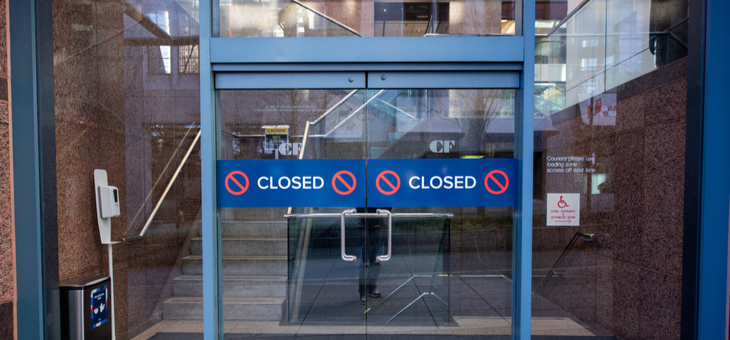Banks are going the way of the milk bar, grocer and fishmonger, disappearing from suburban shopping strips and regional towns, but the rate of closures has even surprised those supposedly in the know.
Information that has come to light this week reveals that the ‘big four’ will have closed or plan to close 350 branches between January 2020 and Christmas 2021 – that’s a little over three a week – leaving all those unwilling or unable to go online forced to travel farther afield to manage their finances. Or if they’re lucky, they could do the bare minimum at a newly minted Australia Post office, which has stepped into the breach.
Read more: Farewell banks, and cheques
The banks point to COVID and online habits to justify the acceleration in closures.
ANZ is the frontrunner with 145 branches shutting down, followed by Westpac with 80, NAB with 72 and the Commonwealth Bank with 53.
The Finance Sector Union was shocked by the sheer scale of the disappearing act, revealed by questions on notice to a parliamentary committee given the task of reviewing the four majors. The 350 tally was 50 more closures than the union last estimated in April.
An ANZ spokesman told the Australian Financial Review that the shift towards digital had occurred faster than anyone had predicted, but its customer care team stood ready to help those make the transition to digital banking.
“This has been one of the biggest changes across the industry, and the broader economy in recent years, as people go online for everyday things such as grocery shopping, watching a film or even doing their tax return,” the spokesman told the AFR.
Cold comfort for all those customers who simply don’t have the capacity to go online.
Read more: Bankers behaving badly
And as ANZ chose not to transfer its banking to Australia Post because of a $22 million fee, it appears many ANZ customers have no choice but to vote with their feet.
Mortlake residents know only too well, with the western Victorian town of 1300 losing its only bank – an ANZ branch – in March. The nearest bank is in Camperdown, 40km down the road.
“It’s inconvenient,” Mortlake resident Jill Parker told The Age back in April.
Some residents can withdraw and deposit money at the post office, but not Ms Parker, who’s been an ANZ customer for 50 years.
“If we want cash, we have to drive for half an hour and that’s if you have a car,” she said. “There are still times when you need cash and a lot of people, particularly older people, are not used to using bank cards.”
Never mind digital services.
National Seniors Australia chief advocate Ian Henschke said that with more than 2.5 million Australians offline, the banks had a social responsibility to keep branches open, calling the closures a “form of institutionalised elder abuse”.
“There is a general level of anxiety and frustration, not just with banks, but with all institutions that expect people to be online,” he told The Age.
“They expect older Australians to go out and buy a smartphone when the money they spend is just extra revenue for the bank.”
Read more: Financial elder abuse on the rise
At least the rest of the big four are providing a lifeline. The Commonwealth Bank, which has the most shopfronts of the big four with 928 locations nationwide, NAB and Westpac are supported by 3500 Australia Post outlets via the Bank@Post deal.
This month, CBA extended the arrangement by 10 years in an effort to leave no customer behind. NAB likewise extended its Australia Post deal for another decade, with the bank estimating some 260,000 customers have used the service.
Westpac, which recently extended its Australia Post contract for just one year, has Australia’s second-largest branch network, with 840 locations.
The Bank@Post service, though, is as basic as they come, allowing customers to only withdraw and deposit money, and to check their balance.
Finance Sector Union national secretary Julia Angrisano said digital migration was merely an excuse to cut costs and the new service simply wasn’t good enough.
“Senior managers who increase profits by cutting costs and overheads are rewarded with fat bonuses. It’s as simple as that,” Ms Angrisano told the AFR.
“Bank branches close down when they are not generating enough profits from writing new loans or signing customers up for new credit cards or banking products they don’t need.”
Has your local bank branch closed or cut hours? Are you comfortable doing all your banking online? Share your thoughts and tips in the comments section below.
If you enjoy our content, don’t keep it to yourself. Share our free eNews with your friends and encourage them to sign up.

